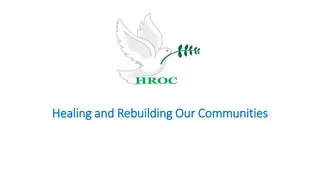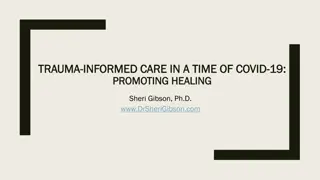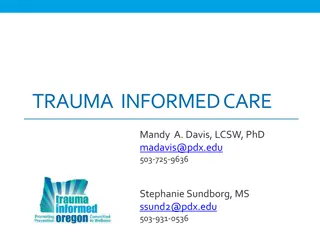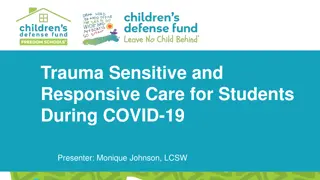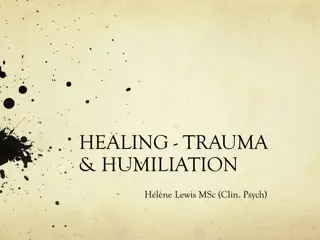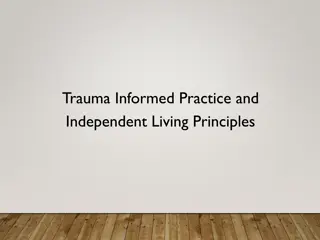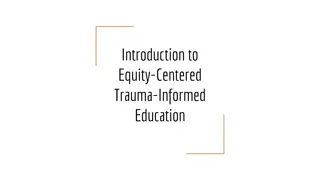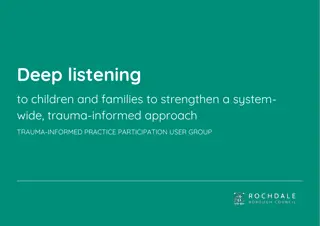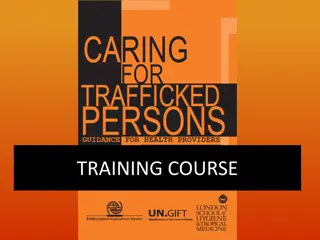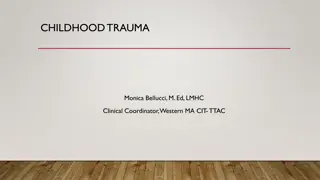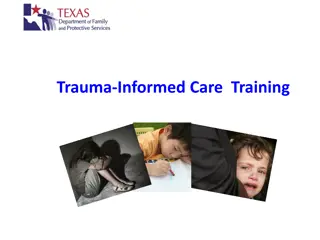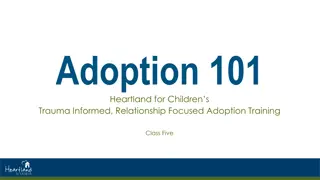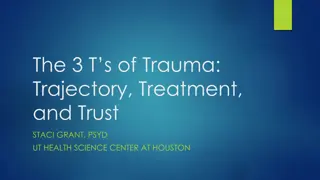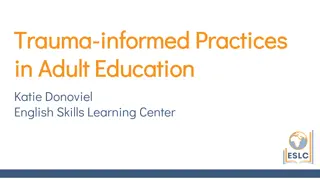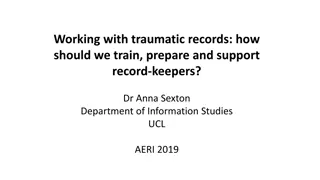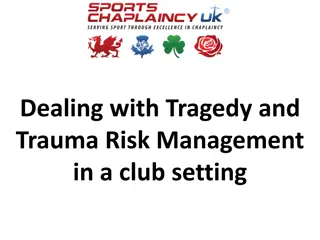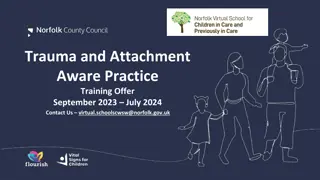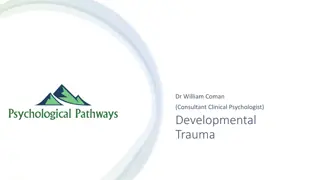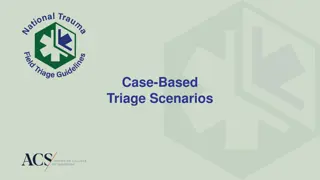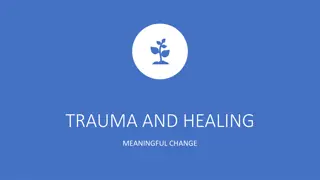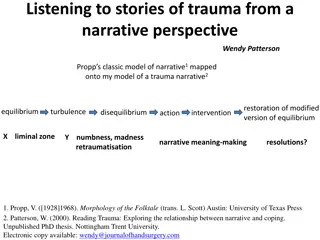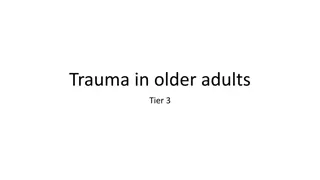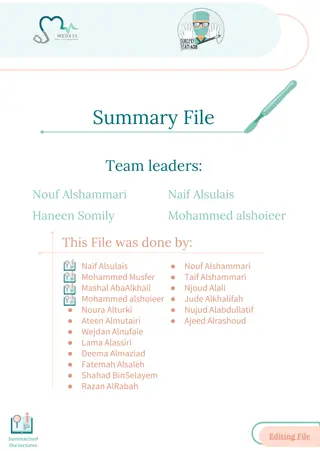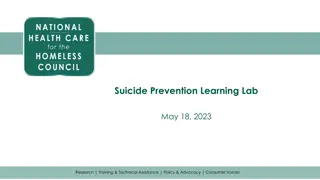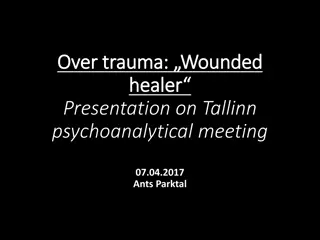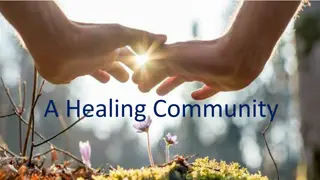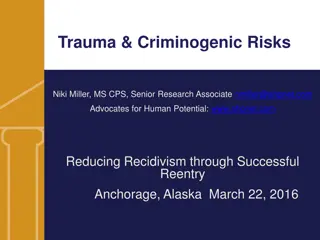Trauma-Informed Care in a Time of COVID-19: Direct Care Promoting Healing
Understanding trauma and its impact in the context of COVID-19 is crucial for providing effective care. Individual responses to trauma are multifaceted, influenced by various pre-pandemic circumstances and exposures encountered during the pandemic. Implementing trauma-informed care practices is essential to support individuals through these challenging times, emphasizing the importance of prevention and effective treatment.
Download Presentation

Please find below an Image/Link to download the presentation.
The content on the website is provided AS IS for your information and personal use only. It may not be sold, licensed, or shared on other websites without obtaining consent from the author. Download presentation by click this link. If you encounter any issues during the download, it is possible that the publisher has removed the file from their server.
E N D
Presentation Transcript
TRAUMA-INFORMED CARE IN A TIME OF COVID-19: DIRECT CARE PROMOTING HEALING Sheri Gibson, Ph.D. sherigibson2@gmail.com www.DrSheriGibson.com
Individual Responses are Multifaceted Pre-pandemic circumstances and resources Prior exposure to adversity Physical and mental health vulnerabilities Economic and social supports Exposures encountered since the pandemic: Illness of a family member Loss of job or health insurance Job status essential health care workers Time immersed in social media, news, over-exposure to information Community-level stressors e.g., Hot spots
Trauma-Informed Care SAMHSA s Trauma-Informed Approach: Behavioral Health is essential to health Prevention works Treatment is effective
Trauma Informed Care Elements Understanding the prevalence of trauma Recognizing how trauma impacts individuals Putting this knowledge into practice to actively resist re-traumatization SAMHSA
Prevalence of Trauma: Approach Video: Power of Empathy https://www.youtube.com/watch?v=1Evwgu369Jw
What is Trauma? Individual trauma results from an event, series of events, or set of circumstances experienced by an individual as physically or emotionally harmful or life threatening and that has lasting adverse effects on the individual s functioning and mental, physical, social, emotional, or spiritual well-being
Potential Traumatic Events Chronic Stressors Poverty Racism Invasive medical procedure Community trauma Historical trauma Family member with substance use disorder Abuse Emotional Sexual Physical Domestic violence Witnessing violence Bullying Cyberbullying Institutional Loss Death Abandonment Neglect Separation Natural disaster Accidents Terrorism War
Prevalence of Trauma Exposure to trauma is ubiquitous: seven out of ten respondents worldwide and nine out of ten adults in the USA report experiencing one or more lifetime traumas. Fink, Galea, 2015
Impact of Trauma on the Brain The brain has a bottom-up organization Experiences build brain architecture Fear activates the amygdala and shuts down the frontal lobes of the cortex. Toxic stress derails healthy development, and interferes with normal functioning Perry, 2006
Impact of Trauma: Adverse Childhood Experiences CDC
Impact of Trauma The effect of trauma on an individual can be conceptualized as a normal response to an abnormal situation
Impact of Trauma: Problems OR Adaptations? Non-compliant, combative OR Struggling to regain or hold onto personal power Fight Treatment resistant, uncooperative OR Disengaging, withdrawing Flight Passive, unmotivated OR Giving in to those in power Freeze
Impact of Trauma: Signs of Trauma Responses Flashbacks or frequent nightmares Sensitivity to noise or to being touched Always expecting something bad to happen Not remembering periods of one s life Feeling emotionally numb Lack of concentration Irritability Excessive watchfulness, anxiety, anger, shame or sadness Additional Signs
Practice of Trauma Informed Care during COVID-19
Trauma Brain = Dysregulated Behavior As residents anxiety increases, their thinking brains become less engaged and behavior becomes more dysregulated. YOU can develop skills to help residents regulate and related by becoming calmer and more connected. This is achieved by: Warmth Validation Flexibility Structure Hope for the future Humor Being part of a connected community
Trauma Informed Care Skill Development: Identifying and Validating Feelings People who have experienced traumatic events, particularly at the hands of a significant caregiver, were given contradictory messages, dismissed, ignored, silenced, abandoned, blamed, shamed, told they had no rights to feel, etc. You have repeated opportunities to offer corrective experiences.
Trauma Informed Care Skill Development: Identifying and Validating Feelings I am able to verbally reflect other s emotional state. It sounds like you feel very angry about this. I know when I am feeling tired, angry, sad, frightened, etc. I can read non-verbal emotional cues, e.g., eye contact, facial expression, tone of voice, body posture, movement and gestures, rhythm and rate of voice. After reflecting feelings, I am able to validate the emotion. You had to wait three days for me to return your call, and your question was really important to you. I understand why you re mad about this.
Trauma Informed Care Skill Development: Regulating Feelings A significant outcome of having an overwhelmed nervous system is emotional dysregulation. This can make it harder to use skills learned in the past. Dementia can also undermine accessing skills to regulate emotions.
Trauma Informed Care Skill Development: Regulating Feelings When I start to feel overwhelmed, I know how to bring myself back to emotional balance. I am equipped to engage with others who are experiencing overwhelming feelings and am able to help them manage these feelings. I am aware of GROUNDING strategies (e.g., focus on breathing, sensory strategies, redirecting attention).
Trauma Informed Care Skill Development: Understanding the Stress Response The nervous system s most important function is to keep us alive by alerting us to danger. Many people are under and/or over responsive to even the slightest perception of danger. Behaviors may include violence, running away, self- abuse or shutting down.
Trauma Informed Care Skill Development: Open and Respectful Communication Many trauma experiences are dehumanizing, leaving people feeling shame and internalized judgment. Judgmental or clinical language may reinforce these beliefs. This language also allows staff to put clients in an other category, ex: this person is very different from me. This type of distance may prohibit the formation of a therapeutic/healing relationship.
Trauma Informed Care Skill Development: Appreciation The survival brain becomes preoccupied with pain & danger but can be distracted when redirected and reminded of pleasure, fun, security, belonging, joy, beauty, humor, etc.
Trauma Informed Care Skill Development: Reason for Being I have a deep connection to things that are important to me. I am able to talk to other people about what makes them unique and to help them connect with activities that promote a sense of hope and value. Most of the time, I believe my life has purpose and meaning.
Trauma Informed Care: Further Reading Judith Herman (2015) Trauma and Recovery Linda Sanford (1991) Strong at the Broken Places Robert Sapolsky (2004) Why Zebras Don t Get Ulcers Bessel Van Der Kolk (2014). The Body Keeps the Score
Trauma Informed Care: Bibliography Alameda County Behavioral Health Care Services. Trauma Informed Care. alamedacountytraumainformedcare.org Brown, D. W., Anda, R. F., Tiemeier, H., Felitti, V. J., Edwards, V. J., Croft, J. B., & Giles, W. H. (2009). Adverse childhood experiences and the risk of premature mortality. American Journal of Preventive Medicine, 37, 389 396. Centers for Disease Control and Prevention. About the CDC-Kaiser ACE Study. https://www.cdc.gov/violenceprevention/acestudy/about.html
Trauma Informed Care: Bibliography Felitti, Vincent J.; Anda, Robert F.; Nordenberg, Dale; Williamson, David; Spitz, Alison; Edwards, Valerie; Koss, Mary; and Marks, James. (1998) Relationship of Child Abuse and Household Dysfunction to Many of the Leading Causes of Death in Adults. American Journal of Preventive Medicine, 14:4, 245-258. Fink, David S., and Galea, Sandro. (2015). Life Course Epidemiology of Trauma and Related Psychopathology in Civilian Populations. Curr Psychiatry Rep, 17:31. Lieberman, Leslie. Walking the Walk: Modeling Trauma Informed Practice in the Training Environment. Multiplying Connections.
Trauma Informed Care: Bibliography Mueser, K.T., Salyers, M.P., Rosenberg, S.D., Goodman, L.A., Essock, S.M., et al. (2004). Interpersonal Trauma and Posttraumatic Stress Disorder in Patients With Severe Mental Illness: Demographic, Clinical, and Health Correlates. Schizophrenia Bulletin, 30 (1), 45-57 Read et al, 2008 National Center for PTSD. http://www.ptsd.va.gov/public/pages/ptsd_substance_abuse_veterans.asp Perry, B. D. (2006). Applying principles of neurodevelopment to clinical work with maltreated and traumatized children: The neurosequential model of therapeutics. In Boyd- Webb, N, ed. Working with traumatized youth in child welfare. New York: Guilford Press.
Trauma Informed Care: Bibliography Substance Abuse and Mental Health Services Administration, Center for Mental Health Services, National Center for Trauma Informed Care. SAMHSA s Trauma Informed Approach: Key Assumptions and Principles Curriculum. Substance Abuse and Mental Health Services Administration. SAMHSA s Concept of Trauma and Guidance for a Trauma Informed Approach. HHS Publication No. (SMA) 14-4884. Rockville, MD: Substance Abuse and Mental Health Services Administration, 2014. SAMHSA (2011). Current Statistics on the Prevalence and Characteristics of People Experiencing Homelessness in the United States. http://homeless.samhsa.gov/ResourceFiles/hrc_factsheet.pdf SAMHSA (2009) Substance Abuse Treatment: Addressing the Specific Needs of Women. Treatment Improvement Protocol (TIP) Series, No. 51. Center for Substance Abuse Treatment. Rockville (MD): Substance Abuse and Mental Health Services Administration.
Trauma Informed Care: Bibliography Wisconsin Department of Health Services. Trauma Informed Care Skill Development. Wisconsin Department of Health Services, Division of Mental Health and Substance Abuse Services. https://www.dhs.wisconsin.gov/tic/skilldev.pdf
Trauma-Informed, Person-Centered Care Resources NORC Trauma-informed care https://ltcombudsman.org/issues/trauma-informed-care Person-centered care - https://ltcombudsman.org/issues/person-centered-care Consumer Voice Resident-Directed Care/Culture Change https://theconsumervoice.org/issues/for- advocates/resident-directed-care My Personal Directions for Quality Living - Blank Form & Sample A tool from Consumer Voice, with edits by SAGE, for individuals to share what matters to them for person-centered care. Information for LTC consumers - https://theconsumervoice.org/issues/recipients Information for Family Members - https://theconsumervoice.org/issues/family
Resources National Long-Term Care Ombudsman Resource Center (NORC) www.ltcombudsman.org Coronavirus Prevention in Long-Term Care Facilities: Information for Ombudsman Programs https://ltcombudsman.org/omb_support/COVID-19 National Consumer Voice for Quality Long-Term Care (Consumer Voice) www.theconsumervoice.org Coronavirus in Long-Term Care Facilities: Information for Advocates https://theconsumervoice.org/issues/other-issues-and-resources/covid-19 Coronavirus in Long-Term Care Facilities: Information for Residents and Families https://theconsumervoice.org/issues/other-issues-and-resources/covid-19/residents-families
Connect with us: www.ltcombudsman.org ombudcenter@theconsumervoice.org cid:image003.jpg@01CFB310.A36779F0 The National LTC Ombudsman Resource Center cid:image004.jpg@01CFB310.A36779F0 @LTCombudcenter Get our app! Search for "LTC Ombudsman Resource Center" in the Apple Store or Google Play This project was supported, in part, by grant number 90OMRC0001-01-00, from the U.S. Administration for Community Living, Department of Health and Human Services, Washington, D.C. 20201. Grantees undertaking projects under government sponsorship are encouraged to express freely their findings and conclusions. Points of view or opinions do not, therefore, necessarily represent official Administration for Community Living policy.



